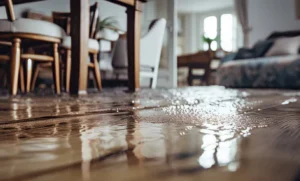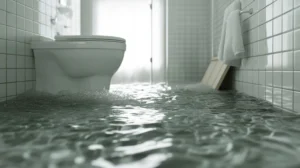Summer in Texas and Oklahoma brings scorching temperatures, high humidity, and overworked air conditioning systems. While homeowners focus on keeping living areas cool, one critical space often goes overlooked: the crawl space. Excess moisture in a crawl space can lead to mold growth, wood rot, and poor indoor air quality—ultimately jeopardizing your home’s comfort and value. At Mr. Restore, we’re emergency restoration experts who understand that preventing mold begins with controlling humidity at its source. In this article, we’ll explain why investing in a crawl space dehumidifier is essential, especially during June’s peak heat, and provide actionable steps to keep your home dry and mold-free.1. Why Crawl Space Humidity Spikes in Texas & Oklahoma Summers
1.1. Hot, Humid Air Infiltration
High Outdoor Humidity: Texas and Oklahoma summers often exceed 60–70% relative humidity. Warm, moisture-laden air naturally seeps into crawl spaces through foundation vents, gaps, and cracks.
AC Unit Strain: As air conditioning systems run continuously to combat outdoor heat, cold air pumped into the home can cause condensation on ductwork and crawl space surfaces—adding even more moisture to an already humid environment.
1.2. Ground Moisture & Poor Ventilation
Soil Evaporation: Damp soil beneath your home can radiate moisture upward, especially after spring rains.
Static Airflow: Many older crawl spaces rely on passive venting. During peak heat, vents allow humid air to swirl under the home, creating a breeding ground for mold and mildew.
1.3. Consequences of Excess Moisture
Mold and Mildew Growth
Mold spores thrive in damp, dark environments. Common molds (Aspergillus, Cladosporium) can colonize wood beams, insulation, and stored items if relative humidity exceeds 60%.
Wood Rot and Structural Damage
Prolonged exposure to moisture weakens wooden support beams and floor joists. Over time, wood rot can lead to sagging floors, joist failure, and costly structural repairs.
Poor Indoor Air Quality
Mold spores and musty odors from the crawl space can infiltrate living areas, aggravating allergies, asthma, and other respiratory issues.
Higher Energy Bills
A damp crawl space makes your HVAC unit work harder—wasted energy translates to higher electric bills.
2. Why a Crawl Space Dehumidifier Is Your Best Defense
2.1. Reducing Relative Humidity (RH) Year-Round
A crawl space dehumidifier is specifically engineered to maintain optimal RH levels (between 30%–50%) under your home. By continuously extracting moisture from the air, the dehumidifier:
Inhibits Mold Growth: Most mold species cannot grow if RH stays below 60%.
Protects Structural Elements: Dry wood is strong wood—preventing decay and rot.
Improves Energy Efficiency: A drier crawl space reduces thermal bridging, making it easier for your AC to cool the home.
2.2. Improves Indoor Air Quality
Since crawl spaces connect to living areas via ductwork, floor joists, and radial airflow, controlling humidity below helps limit the transfer of musty air and mold spores into your home’s interior. Families with small children, elderly relatives, or those with asthma will appreciate the reduction in airborne contaminants.
2.3. Extends HVAC and Appliance Lifespan
Moisture can corrode air ducts, plumbing pipes, and HVAC components. By lowering RH under the home, you reduce the risk of rust, corrosion, and premature equipment failure—saving you on future repair and replacement costs.
3. Choosing the Right Crawl Space Dehumidifier
Not all dehumidifiers are created equal. To ensure you select the optimal unit for your Texas or Oklahoma home, consider these factors:
3.1. Capacity & Coverage
Pint-Per-Day Rating: Measured in pints (or liters) per 24 hours, capacity typically ranges from 30–95 pints or more. For a 1,000–1,500 sq. ft. crawl space with moderate to high humidity, aim for a 70–95 pint dehumidifier.
Square Footage Coverage: Always check the manufacturer’s guidelines. A 70-pint unit might cover up to 2,000 sq. ft in optimal conditions—verify that the rating aligns with your crawl space size and humidity level.
3.2. Built-In Drainage Options
Gravity Drain: If your crawl space has a nearby sump pump or floor drain, a dehumidifier with a built-in gravity‐drain hose makes maintenance simple: it runs directly to the drain without manual emptying.
Condensate Pump: For crawl spaces without a floor drain, choose a model with an integrated condensate pump. These pumps automatically push collected water up to your home’s utility area or a nearby sink.
3.3. Energy Efficiency & Durability
ENERGY STAR® Certification: Look for Energy Star rated models to save on electricity—even though nominal, these savings add up over Texas/Oklahoma summers.
HVAC-Grade Compression: Since crawl spaces can dip below 50°F in winter, ensure the dehumidifier uses a low-temperature compressor (some units have auto-defrost).
3.4. Installation Location & Ventilation
Position the unit on a stable, level platform—often on concrete blocks or a plywood platform—at least 2–3 inches off the crawl space ground.
Ensure there’s a minimum of 6–12 inches clearance around all sides for optimal air intake and exhaust.
If possible, install the dehumidifier centrally under the home to guarantee even moisture extraction.
4. Step-by-Step Installation Guide
4.1. Prepare the Crawl Space
Clean & Access: Remove debris, old insulation, and any standing water.
Seal Entry Points: Use foam insulation and weatherstripping to seal cracks, foundation vents, and gaps around plumbing penetrations to limit humid air infiltration.
Vapor Barrier Installation (Optional but Highly Recommended):
Lay a 6–mil polyethylene vapor barrier on the ground (over the soil) and overlap seams by 12 inches.
Secure edges to the foundation walls with construction adhesive and tape. This barrier reduces ground-source moisture.
4.2. Position & Level the Dehumidifier
Place the unit on a stable, raised platform in the driest, most central location you can access.
Ensure the dehumidifier is near a power outlet (use a GFCI outlet for safety).
4.3. Connect Drainage
Gravity Drain: Attach a vinyl or PVC hose to the dehumidifier’s drain outlet and run it downhill to a floor drain or sump pit—ensure no kinks or uphill slopes.
Condensate Pump: Position the pump nearby, connect the dehumidifier’s drain port to the pump’s inlet, then route the pump’s discharge hose out of the crawl space to a nearby sink, sump, or condensate drain.
4.4. Power Up & Set Humidity Controls
Plug in the unit; many models have a digital control panel where you can set the target RH (recommend 45% RH during summer months).
Confirm the condensate line is flowing freely. Turn on the dehumidifier and let it run for at least 24–48 hours to gauge performance:
Check Bucket/Drain Flow: Ensure the unit is collecting moisture and draining correctly.
Monitor RH Readings: Use a stand-alone hygrometer placed in another area of the crawl space to confirm even humidity reduction.
5. Maintenance & Best Practices
5.1. Monthly Checks
Filter Cleaning: Most units have an air filter that traps dust and debris. Clean or replace per manufacturer instructions (usually once a month during heavy use).
Condensate Line Inspection: Ensure the drain hose or pump tubing remains clear—clean the trap to prevent algae or mold buildup.
5.2. Quarterly Inspections
Vapor Barrier Integrity: Inspect seams and edges for tears or shifted sections. Patch or re-tape as needed.
Dehumidifier Performance: Compare RH readings between the dehumidifier’s hygrometer and your stand-alone meter. If the unit isn’t reaching the setpoint, it may need service or a coil cleaning.
5.3. Seasonal Adjustments
Peak Summer (June–August): Run the unit continuously. Check for performance dips as external humidity peaks; consider lowering the RH setpoint to 40%–45%.
Fall/Winter (September–February): Crawl space temperatures can drop below 50°F. If your unit has an auto-defrost feature, continue operation but monitor for coil icing. If it does not, shut off the dehumidifier when temperatures consistently fall below 50°F, and rely on vapor barrier alone to control ground moisture.
5.4. When to Upgrade or Service
Increased Runtime: If the motor or compressor runs constantly yet fails to lower RH, coils may be dirty or refrigerant may be low—call a certified HVAC technician.
Unusual Noises or Leaks: Gurgling sounds may indicate a pump issue. Clicking or rattling can signal fan/motor problems. Address these immediately to avoid total unit failure.
6. Additional Steps to Reinforce Crawl Space Health
6.1. Insulate Exposed Ductwork & Pipes
Wrap any visible HVAC ducts, plumbing pipes, and hot water lines with foam or fiberglass insulation to minimize condensation.
6.2. Replace Wet or Damaged Insulation
If batt insulation (fiberglass or cellulose) within the crawl space is damp, remove and replace with closed-cell spray foam or rigid foam board insulation on the walls, which doesn’t absorb moisture like traditional batts.
6.3. Foundation & Grading Checks
Ensure the exterior ground slopes away from your home’s foundation. Poor grading can cause rainwater to collect around the foundation, increasing sub-slab moisture that migrates into the crawl space.
7. Connecting to Mr. Restore’s Emergency Services
Even with the best preventive measures, unexpected water events can occur—burst pipes, roof leaks, or flash floods. At Mr. Restore, we specialize in fast, professional restoration to protect your home throughout Texas and Oklahoma:
Our licensed technicians are on call around the clock to address water damage, mold inspections, and structural drying.
Crawl Space Flood Cleanup
If your crawl space floods despite humidity control, our team uses industrial‐grade pumps, moisture meters, and rapid drying techniques to minimize secondary damage.
Moisture Mapping & Monitoring
We deploy thermal imaging and high‐precision hygrometers to ensure your crawl space returns to optimal dryness—preventing hidden pockets of mold growth.
Pro Tip: After installing your dehumidifier, schedule a free crawl space inspection with Mr. Restore. We’ll verify that all moisture control measures are working correctly, and identify any hidden water intrusion issues before they worsen.
In the sweltering Texas and Oklahoma summer heat, a proactive approach to crawl space humidity can save you thousands in mold remediation, structural repairs, and energy costs. Installing and maintaining a quality crawl space dehumidifier—combined with a robust vapor barrier and routine inspections—forms your first line of defense against moisture‐related problems.
At Mr. Restore, we’re committed to helping homeowners keep their homes safe, dry, and comfortable. If you’re ready to protect your crawl space from mold growth and humidity damage, reach out to us today for expert guidance or a comprehensive inspection. Let’s make sure your home stands strong, even when the heat and humidity peak.
Ready to prevent mold in your crawl space? Contact Mr. Restore now at (877) 631-7576 or visit https://.mrrestore.com to schedule your free crawl space assessment. Don’t wait—beat the summer humidity before it beats your home.






